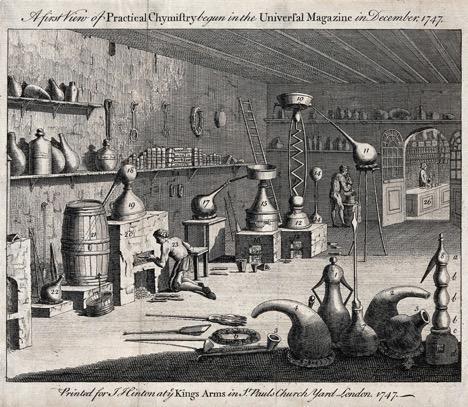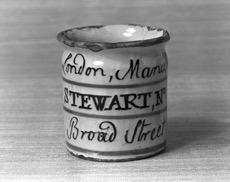Apothecaries could be found behind counters in cities and towns across England, as well as throughout the pages of early medical texts. Alongside druggists, chemists, surgeons, physicians, and countless other caregivers, they vied for a share of a commercializing medical marketplace during the early modern period. This was a competitive undertaking as patients began to spend more on their health beginning in the seventeenth century. Customers in England and its colonies could choose from a wider array of medicinal products than ever before, which apothecaries were all too happy to provide, for a price, of course. Since 1620, the Society of Apothecaries, the company responsible for licensing and examining apothecaries in London, had held a royal monopoly on making and selling medicines in the city and its suburbs. As England’s commercial hub, London remained the center of medical activity, though Bristol and other cities had apothecary institutions as well. As part of this privilege, representatives of the Society could license vendors and inspect their shops within a certain area. Though the apothecaries held this authority on paper for much of the century, in practice it did not amount to much, and they faced challenges as the medicine trade became more lucrative.

View of a seventeenth-century apothecary shop. Frontispiece to Pierre Morel, The expert doctors dispensatory… (London, 1657). Wellcome Collection.
The occupation of apothecary had separated from that of the medieval spicer (who likewise sold a variety of medicinal products) by the seventeenth century. In the 1600s, apothecaries nominally prepared medicines for sale and filled physicians’ prescriptions, though in practice they often did much more, including offering medical advice, importing plantation goods, and providing rudimentary banking services. Apothecaries thus had to possess some degree of literacy and numeracy, similar to other artisans, tradespeople, and merchants involved in long-distance or large-scale trade at the time. In their day-to-day activities, they often blended commercial training, such as how to keep a ledger or convert currencies, with medical training. Their training also combined humanistic learning from books with experiential learning, which could attract the ire of the more formally-trained physicians. In London, much of the training occurred via a seven-year apprenticeship wherein someone wishing to enter the trade was bound to an older apothecary (the master) under the auspices of the Society of Apothecaries. Apprentices would also visit the society’s Chelsea Physic Garden to learn about the medicinal plants that grew there and how to prepare remedies from them. Back at their masters’ shops, apprentices did much of the work of rolling pills, distilling tinctures, and molding plasters from a variety of ingredients. These could be laborious, and sometimes even dangerous, tasks. Distillation equipment could emit noxious fumes, furnaces required regular stoking, and materials had to be transported and manipulated by hand. Besides helping to make medicines, apprentices also tended the shop where they acted as retailer and merchant. At the end of the seven years, following an examination and fee, an apprentice could be called an apothecary and set up his own shop or join his master’s as a partner.

Interior of a chemical laboratory with shop visible through the doorway in the background. From the Universal Magazine (Dec. 1747). Wellcome Collection.
On the other side of the medicine trade, patients had many options for care to choose from. They tried one approach, then another and another. Given the prevalence of home or self-care, an apothecary would often not have been the first option in a time of illness or pain. Nevertheless, the iterative nature of treatment encouraged a diversity of approaches and competition among those who sought to provide it. Without much regulation, especially outside of London, success in this marketplace largely depended on trust. Some apothecaries gained reputations for effective cures, while others faced accusations of adulteration or overcharging. In print and by word of mouth they advertised remedies available for cash or credit, retail or wholesale, in person or by mail. Some of these advertisements are available in the database, such as John Holney’s A brief account of those most excellent and famous cathartick and diuretique pills (London, 1675). Colorful, fragrant roots, herbs, elixirs, salts, and pills displayed in jars, cases, or vials enticed potential customers. Medicines were typically expected to conform to recipes found in widely-circulating medical texts, but many apothecaries also made their own for sale. William Salmon ’s The compleat English physician (London, 1693) offered more than a thousand pages on the medicinal uses of various herbs, minerals, and chemicals, including one of the most popular imported drugs at the time: Jesuit’s or Peruvian Bark. Other prevalent texts, including John Pechey’s A plain introduction to the art of physick (London, 1697) or John Schroeder’s The compleat chymical dispensatory (London, 1669), illustrate the influx of medicines and their widespread production not just by apothecaries but also in kitchens and workshops across England.

Two views of a seventeenth-century ointment jar bearing the manufacturer’s name and address in London. Wellcome Collection.

The aforementioned Salmon, however, was not an apothecary. By the close of the seventeenth century, makers and vendors of medicines in London challenged the institutions that had organized the medical marketplace for centuries. Regulation in the city had rested principally with three professional companies representing the interests of their membership—the Company of Barber-Surgeons after the mid-fifteenth century, the College of Physicians from the early sixteenth, and the Society of Apothecaries since the second decade of the seventeenth—in place of the types of judicial power that developed elsewhere in continental Europe. Officers of the College of Physicians sought to limit certain practitioners, including many apothecaries, from giving medical advice or selling medicines. A good example of such arguments remains Christopher Merret’s A short view of the frauds, and abuses committed by apothecaries (London, 1669) published in the wake of the plague year. Though College censors inspected the shops of apothecaries, druggists, and chemists, by the later seventeenth century their power to do so was effectively defunct. By the early 1700s, apothecaries filled prescriptions for physicians, sold remedies directly to patients, and offered medical advice of their own, a new status quo confirmed by the outcome of the Rose Case in 1704. In the case of William Rose, an apothecary, the House of Lords ruled that apothecaries could visit patients and prescribe remedies, a privilege formerly reserved for physicians, codifying what had already been the practice for years. Though the Rose Case did not itself change what apothecaries did or could do every day, its outcome illustrates that by end of the seventeenth century apothecaries provided a significant portion of medical goods and services in England.
Apothecaries, whether members of the Society or not, would gain more business from plantations, hospitals, the military, and trading companies in the coming years. Since the 1670s there had been a chemical laboratory at their hall in Black Friars near the River Thames where members could prepare and purchase medicines. As they gained prominence, though, apothecaries began to face competition from outside their ranks. Some apothecaries, especially those who had served apprenticeships, paid their dues, and used the laboratory, maintained a good standing within the Society; whereas others, who nonetheless sometimes still called themselves apothecaries, competed with them for customers and contracts. Members of the Society tried to protect their right to regulate vendors of medicines in London—see, for example, The apothecaries reply to the city-reasons against their bill (London, 1694)—though their ability to enforce it waned as had the physicians’. At the start of the eighteenth century, apothecaries and others who manufactured medicines could access markets for their products across England and its colonies that would only continue to expand due in large part to the engines of military fiscalism and slavery.
For Further Reading
Cook, Harold J. “Good Advice and Little Medicine: The Professional Authority of Early Modern English Physicians.” Journal of British Studies 33, no. 1 (1994): 1-31.
Dorner, Zachary. Merchants of Medicines: The Commerce and Coercion of Health in Britain’s Long Eighteenth Century. Forthcoming from the University of Chicago Press.
Mortimer, Ian. The Dying and the Doctors: The Medical Revolution in Seventeenth-Century England. Woodbridge, Suffolk: Boydell Press, 2009
Pelling, Margaret. Medical Conflicts in Early Modern London: Patronage, Physicians and Irregular Practitioners, 1550-1640. Oxford: Clarendon Press, 2003.
Wallis, Patrick and Teerapa Pirohakul. “Medical Revolutions: The Growth of Medicine in England, 1660-1800.” Journal of Social History 49, no. 3 (2016): 510-531.